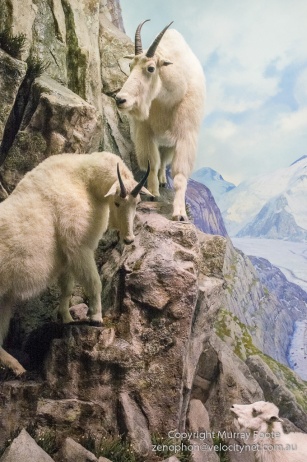
The American Museum of Natural History, like The Met, is so large it takes more than a day to see. Here is a somewhat random selection of exhibits from our second visit. Above we have elks …
… and these are Mountain Goats. Just a couple of the many large three-dimensional dioramas, quite impressive in themselves though with a slightly archaic nineteenth century ethos to them.
This is an opalised ammonite shell from Alberta (inland western Canada). It is from 65 million years ago, when the dinosaurs were about to evaporate and Alberta was under the sea.
This is a full scale replica of the Aztec Stone of the Sun. It is twelve feet in circumference and the original weighs over twenty tons. In the centre is the sun god Tonatiuh.
A Mayan sculptural facade from the “nunnery” quadrangal at Uxmal in the Yucatan. Removed in 1840.
A model of The Castillo at Chichen Itza, in cutaway style to show an earlier building buried within, in a Mayan equivalent of Russian dolls.
A model of Temple IV at Tikal. The original is the highest of all Mayan buildings at 212 feet.
A model of another Mayan building, the Rio Bec B temple. It in in deep jungle in the Campeche province of Mexico, around 80 kilometres north of Tikal. There is an interesting account of a visit there here.
An American Indian headdress from the Amazon.
2 November 2011.








Pingback: New York | Murray Foote
Still, there were some who wouldn’t truly feel safe until the sun sets Friday over the pyramids in the Yucatan peninsula, the heartland of the Maya.
LikeLike
If you’re referring to the end of the Mayan calendar, that’s already been and gone. Still, the world could probably do with a new beginning….
LikeLike
The Temple of the Little Tables, similar in design to the Temple of the Big Tables and Temple of the Warriors to the east, went through several remodeling periods during Pre-Columbian times, with the last period adding a second story to the structure. In addition to sculpted Atlantean figures, serpents, and Chac masks are numerous depictions of jaguars. These are identified by their spots and are accompanied by glyphic inscriptions which read ‘ajaw’ (Mayan word that means ‘lord’ in one definition) and ‘k’awiil’; this combination of elements has led to speculation that the lord or lineage that ruled this palace was named B’alam Ajaw K’awiil (Jaguar Lords).
LikeLike
I’m sure Chichen Itza would be an amazing place to visit.
LikeLike
Note: Its not the Red House. Its Río Bec B.
LikeLiked by 1 person
Thanks very much Wally. I have corrected the description.
LikeLike